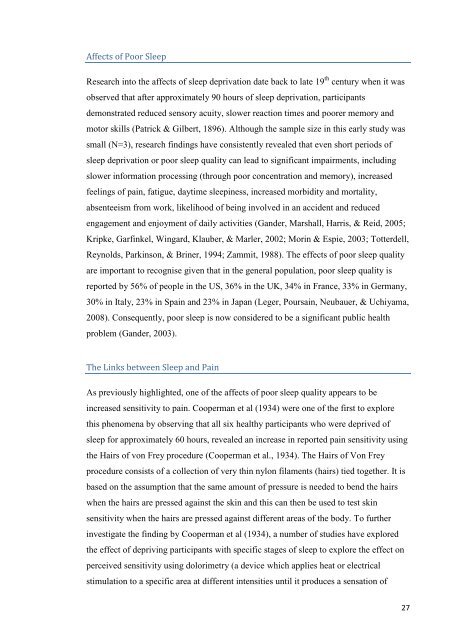Sick and Tired: Understanding and Managing Sleep Difficulties in ...
Sick and Tired: Understanding and Managing Sleep Difficulties in ...
Sick and Tired: Understanding and Managing Sleep Difficulties in ...
Create successful ePaper yourself
Turn your PDF publications into a flip-book with our unique Google optimized e-Paper software.
Affects of Poor <strong>Sleep</strong><br />
Research <strong>in</strong>to the affects of sleep deprivation date back to late 19 th century when it was<br />
observed that after approximately 90 hours of sleep deprivation, participants<br />
demonstrated reduced sensory acuity, slower reaction times <strong>and</strong> poorer memory <strong>and</strong><br />
motor skills (Patrick & Gilbert, 1896). Although the sample size <strong>in</strong> this early study was<br />
small (N=3), research f<strong>in</strong>d<strong>in</strong>gs have consistently revealed that even short periods of<br />
sleep deprivation or poor sleep quality can lead to significant impairments, <strong>in</strong>clud<strong>in</strong>g<br />
slower <strong>in</strong>formation process<strong>in</strong>g (through poor concentration <strong>and</strong> memory), <strong>in</strong>creased<br />
feel<strong>in</strong>gs of pa<strong>in</strong>, fatigue, daytime sleep<strong>in</strong>ess, <strong>in</strong>creased morbidity <strong>and</strong> mortality,<br />
absenteeism from work, likelihood of be<strong>in</strong>g <strong>in</strong>volved <strong>in</strong> an accident <strong>and</strong> reduced<br />
engagement <strong>and</strong> enjoyment of daily activities (G<strong>and</strong>er, Marshall, Harris, & Reid, 2005;<br />
Kripke, Garf<strong>in</strong>kel, W<strong>in</strong>gard, Klauber, & Marler, 2002; Mor<strong>in</strong> & Espie, 2003; Totterdell,<br />
Reynolds, Park<strong>in</strong>son, & Br<strong>in</strong>er, 1994; Zammit, 1988). The effects of poor sleep quality<br />
are important to recognise given that <strong>in</strong> the general population, poor sleep quality is<br />
reported by 56% of people <strong>in</strong> the US, 36% <strong>in</strong> the UK, 34% <strong>in</strong> France, 33% <strong>in</strong> Germany,<br />
30% <strong>in</strong> Italy, 23% <strong>in</strong> Spa<strong>in</strong> <strong>and</strong> 23% <strong>in</strong> Japan (Leger, Poursa<strong>in</strong>, Neubauer, & Uchiyama,<br />
2008). Consequently, poor sleep is now considered to be a significant public health<br />
problem (G<strong>and</strong>er, 2003).<br />
The L<strong>in</strong>ks between <strong>Sleep</strong> <strong>and</strong> Pa<strong>in</strong><br />
As previously highlighted, one of the affects of poor sleep quality appears to be<br />
<strong>in</strong>creased sensitivity to pa<strong>in</strong>. Cooperman et al (1934) were one of the first to explore<br />
this phenomena by observ<strong>in</strong>g that all six healthy participants who were deprived of<br />
sleep for approximately 60 hours, revealed an <strong>in</strong>crease <strong>in</strong> reported pa<strong>in</strong> sensitivity us<strong>in</strong>g<br />
the Hairs of von Frey procedure (Cooperman et al., 1934). The Hairs of Von Frey<br />
procedure consists of a collection of very th<strong>in</strong> nylon filaments (hairs) tied together. It is<br />
based on the assumption that the same amount of pressure is needed to bend the hairs<br />
when the hairs are pressed aga<strong>in</strong>st the sk<strong>in</strong> <strong>and</strong> this can then be used to test sk<strong>in</strong><br />
sensitivity when the hairs are pressed aga<strong>in</strong>st different areas of the body. To further<br />
<strong>in</strong>vestigate the f<strong>in</strong>d<strong>in</strong>g by Cooperman et al (1934), a number of studies have explored<br />
the effect of depriv<strong>in</strong>g participants with specific stages of sleep to explore the effect on<br />
perceived sensitivity us<strong>in</strong>g dolorimetry (a device which applies heat or electrical<br />
stimulation to a specific area at different <strong>in</strong>tensities until it produces a sensation of<br />
27

















